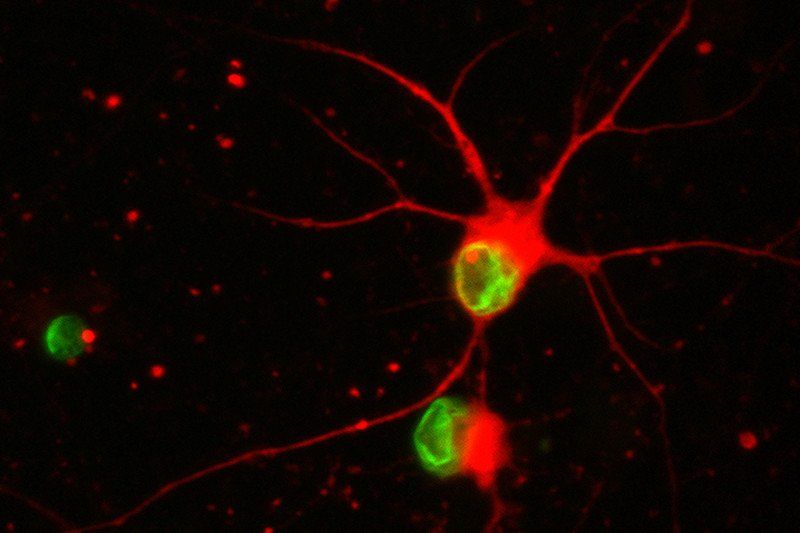
When stem-cell-derived nerve cells exposed to progerin (shown in green) begin to degenerate, their long, branch-like processes progressively shorten, then disappear. The top right cell is still healthy; the cell below it has begun to degenerate. The left-hand cell has lost its processes and is dying.
Methods to generate artificial stem cells have been a game changer in the study of some genetic diseases. Researchers can take a small number of skin cells from a patient and reprogram them to become the disease-affected cell type – such as heart, brain, or liver cells. This technique avoids the use of embryos while providing a limitless supply of material to study what goes wrong in the disease.
But thus far, artificial stem cell technology has not been used successfully to study the later stages of age-related diseases such as Parkinson’s and Alzheimer’s. When a patient-derived cell is reprogrammed into a stem cell its biological age is reset to the embryo stage. These immature cells cannot accurately model diseases that take hold in later life.
Now Memorial Sloan Kettering researchers have discovered how to overcome the rejuvenating effects of stem cell reprogramming. In the December issue of Cell Stem Cell, Lorenz Studer and colleagues report a method to grow aged brain cells from stem cells.
Their breakthrough approach removes a major obstacle to using stem cells to study Parkinson’s and could transform research into other degenerative diseases and age-related cancers.
Modeling Disease
To replicate a disease state in a dish, scientists first make stem cells from mature patient cells, such as skin cells. Genes inserted into the skin cell’s DNA cause the cells to regress to an immature state. Like natural stem cells from embryos, these cells have the capacity to develop into virtually any cell type.
Next these artificial stem cells, called induced pluripotent stem cells, or iPSCs, are carefully grown in the lab and matured to become the cell type of interest. The iPSC-derived cells carry the same genetic defects as the patient and can reproduce the molecular processes that drive the disease.
Focus on Parkinson’s
Dr. Studer had past success using iPSCs, to uncover the basis of a rare nervous system disorder affecting children called familial dysautonomia. Most recently he used iPSC technology to identify candidate drugs for this disease.
But he has been unable to use iPSC technology to model Parkinson’s, the main disease focus of his laboratory. “We can generate nerve cells from stem cells that we know have the genetic defects that predispose to Parkinson’s, but under the microscope the cells behave exactly the same as healthy cells, because the cells are young,” Dr. Studer explains.
It would take decades for the nerve cells to grow old naturally, so Dr. Studer looked to nature for ideas on how to fast-forward the aging process. The answer came from a very rare genetic disease in which aging is accelerated due to a mutant protein called progerin.
When the team treated stem-cell-derived nerve cells with progerin, they witnessed a remarkable effect: The nerve cells began to age rapidly and within a matter of days displayed many signs of cell aging, including DNA damage and changes to cell energy production. “It was pretty shocking,” recalls Dr. Studer. “We thought we might get one or two markers. No one believed that it was going to work so well.”
Next the researchers made stem cells from individuals with Parkinson’s disease and generated the type of nerve cell that dies off in Parkinson’s. When the nerve cells were treated with progerin, they developed the characteristic features of Parkinson’s and began to degenerate.
“We could reproduce features of the disease that were not possible to model in previous efforts studying Parkinson’s disease in a dish,” says first author on the paper, Justine Miller, who is a student of the Louis V. Gerstner, Jr. Graduate School of Biomedical Sciences of Memorial Sloan Kettering. “We hope that the strategy will help us to explain why the disease is late onset. We also think that it could provide a more effective approach to identify new drugs that treat late-onset diseases and prevent neurodegeneration.”
Future Vision
The age-accelerating effects of progerin on stem cells could provide better cell-based models for fundamental research and drug discovery in a range of age-related degenerative conditions, for example Alzheimer’s, arthritis, and hearing loss. The approach could also provide new ways to look at cancers that appear later in life, such as prostate and breast cancers, and understand why age is an important risk factor.
Dr. Studer suggests that the approach developed by his lab could also one day be used as the basis of a lab test to predict which cancers people are at risk of developing in later life, allowing them to take preventative action through lifestyle choices or medical intervention.
He explains, “It’s a futuristic vision, but one can imagine that it may be possible to reprogram skin cells from a young person into various cell types, such as blood or liver, then forward-wind the age of the cells and test which age-related cancers that person is susceptible to, for example by challenging the cells with cancer-causing genes.”
Read Dr. Studer’s perspective on the Nobel Prize–winning research that led to the development of iPSCs.







